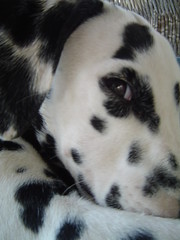 As I have mentioned in a few other posts, the vast majority of behaviors that we deem problematic in our dogs, such as, barking, biting, lunging, destruction, separation anxiety or resource guarding, stem from the dog’s fear, anxiety or panic. Caution and fear help animals of all species, including humans, avoid danger. The downside: fearful experiences can have a lasting impact and be triggered even in situations where there isn’t a real threat and may affect the animals for the rest of their life, and even beyond… Although the different studies that I will refer to apply to all mammals, the comments of this blog are more specific to dogs. Through exposure and desensitization, we can often help our dog re-gain confidence in the presence of the scary stimulus, but research also shows that relapse is not uncommon. Moreover, a recent study suggests that traumatic events can be passed down from one generation to another through chemical changes associated with the DNA. These findings give yet more reasons to watch for behavioral traits when selecting dogs for breeding. Preventing the occurrence of fear in the first place should also be on our priority list when raising a dog. Through proper socialization and exposure, while avoiding coercion-based methods that tend to increase stress and anxiety, we can help the dog develop confidence and coping skills and minimize the impact of unfamiliar or sudden stimuli.
As I have mentioned in a few other posts, the vast majority of behaviors that we deem problematic in our dogs, such as, barking, biting, lunging, destruction, separation anxiety or resource guarding, stem from the dog’s fear, anxiety or panic. Caution and fear help animals of all species, including humans, avoid danger. The downside: fearful experiences can have a lasting impact and be triggered even in situations where there isn’t a real threat and may affect the animals for the rest of their life, and even beyond… Although the different studies that I will refer to apply to all mammals, the comments of this blog are more specific to dogs. Through exposure and desensitization, we can often help our dog re-gain confidence in the presence of the scary stimulus, but research also shows that relapse is not uncommon. Moreover, a recent study suggests that traumatic events can be passed down from one generation to another through chemical changes associated with the DNA. These findings give yet more reasons to watch for behavioral traits when selecting dogs for breeding. Preventing the occurrence of fear in the first place should also be on our priority list when raising a dog. Through proper socialization and exposure, while avoiding coercion-based methods that tend to increase stress and anxiety, we can help the dog develop confidence and coping skills and minimize the impact of unfamiliar or sudden stimuli.
Fear occurs when the animal experiences something unpleasant; like a loud and sudden sound, sudden movement, the sudden presence of unfamiliar people or animals, pain, etc. In many cases, the animal learns to fear the object of the emotion itself (the unconditioned stimulus), but may also associate anything else that is present in the situation, as part of the event. This phenomena has been shown in laboratory experiments where a neutral stimulus, like a green light, is systematically followed by an aversive (like an electric shock). Over time, through classical conditioning, the animals start reacting to the green light alone.
Once a dog is showing clear signs that he/she is afraid of something, there are 3 main techniques to help reduce or eliminate the fear. The success of any of these methods largely depends on our ability to stay sub-threshold, in other words, to monitor the level of the stimulus (closer, louder, bigger, etc.), so that it doesn’t trigger fear in the animal:
- Classical conditioning/Desensitization: the animal is exposed to slowly increasing levels of the stimulus while provided with something pleasant (generally food). Giving a dog high value treats while looking at something that generally triggers and emotional reaction, like another dog or person for instance, is an easy and effective way to reduce or eliminate fear responses.
- Operant conditioning/desensitization: another approach is to teach the dog to perform a certain behavior when seeing the scary stimulus, then get a reward for doing so. The presence of the other dog or person (scary stimulus) becomes the cue to turn away from it and look at the handler (auto watch).
- Operant conditioning: instead of teaching the dog to perform a certain behavior, we can reinforce the dog for choosing an alternative behavior to lunging, barking, snarling, etc. The dog is exposed to the triggering stimulus and reinforced as soon at he/she volunteers a more acceptable behavior like, looking away, sitting, sniffing the ground, just looking without barking, etc. As soon as the dog offers a different behavior, either the scary stimulus goes away (Constructional Aggression Treatment (CAT)) or the dog is taken away (Behavior Adjustment Training (BAT). In this case the dog is reinforced twice, once with food for choosing an alternative behavior and a second time by the increase in distance with the scary stimulus.
These methods have proven to be very successful in most cases. However, the real challenge with fear is to maintain the treatment over time. Unfortunately, relapse is frequent and fears can come back. In humans, the reoccurrence of phobias after treatment is estimated between 19% and 62% (Craske & Mystkowski, 2012). 27% of patients treated for panic disorders also relapsed (Fava & al. 2001). How easily fears can come back is based in the process of how they’re acquired in the first place.
To understand how this works in dogs, let’s go back to the example with laboratory rats, of the green light that precedes an electric shock. In learning theory, we can say that this experience leaves a memory trace that has three components: 1/ a mental representation of the electric stimulation, the shock (unconditioned stimulus (US)), 2/ a mental representation of the light (conditioned stimulus (CS)) and 3/ the association between both these representations. Anytime the animal sees the green light, a mental representation will be activated, but since it’s also associated with the shock, so is the memory of the painful stimulation. Fear happens when we anticipate an unpleasant experience, in that sense, it’s always based on what could happen in the future, not what is happening in the moment. Fear keeps us alive because it pushes us to take action before something bad happens. That’s why, even though the light in itself doesn’t hurt, it will elicit fear so the animal can do something to avoid the pain.
In this model, there are two main ways that treatment could be processed in the brain and affect change. If the light is now repeatedly followed with food, for instance, seeing the green light will no longer bring up the memory of the unpleasant experience and the animal won’t be scared anymore. One possibility is that the intensity of the fear can be reduced, by destroying the association between the green light and the electric shock. A second possibility is that the association between the light and the shock remains intact but is simply inhibited. If the light is repeatedly paired with food, this second association may counteract the first one. So it’s not that the association doesn’t exist anymore, it is simply inhibited by a new learned experience. Of course the destruction of the association between the light and the electric shock is the best outcome. In this case, the chances of the fear coming back are very slim. When the memory is simply inhibited however, the chances of the memory coming back with full force are still there. If for some reason the inhibiting association between the green light and food weakens, the fear may very well return.
Here are a few situations that may bring back fear:
- The aversive stimulus is presented again to the animal. If the animal is shocked again, for instance, there is a good chance that the representation of the shock, along with the associated green light, will be remembered. The animal will then be scared of the green light alone, all over again.
- When we’re working on extinguishing fear, it is also possible that only some of the elements of the initial situation are present. It would be very difficult to reproduce the exact same conditions as they were at the time of the scary event. It’s impossible to know which elements of that situation have been memorized and made part of the experience. In the case of an intense event, it sometimes only has to occur once to have a lasting effect on the animal. The problem then is that the memory of the event, and therefore the fear, may come back when in presence of the some of the other elements also memorized but not part of the treatment protocol.
- New fears can trigger old fears. Once the fear has been extinguished, if the animal experiences another aversive in the presence of the same stimulus (e.g.: green light), the fear can come back.
What can we do to prevent relapse?
The sooner we intervene, the better. Whenever possible, helping the animal overcome a fearful situation can greatly reduce the odds of that fear having a lasting effect (Myers & al., 2006). Essentially, early intervention prevents the consolidation of the association between the conditioned stimulus (CS) and the unconditioned stimulus (US) in the memory. In other words, when a dog experiences pain (US) in the presence of a person with an umbrella (CS) and expresses fear, we need to immediately take action to avoid a lasting connection to develop between the pain and people carrying umbrellas. Through classical conditioning, by giving the dog treats, for instance, we can help her overcome the fear and develop a more positive experience. If we refer back to the model explained above, we are then destroying the first association (umbrella + pain) and replacing it with a second association (umbrella + food), thus increasing our chances of treating the fear once and for all.
Another reason why it’s so important to deal with fears as soon as they occur, is that fearful memories will not only affect the dog’s behavior during his/her lifetime, but can also be passed down to later generations! New research found that learned fears may produce a change in the animal’s DNA expression (Dias & Ressler, 2013). When mice learn to fear the smell of cherry blossom, their offspring will also exhibit the same reactions to the smell, even though they never experienced anything unpleasant associated to that pain. The brains of the trained mice, as well as that of their offspring showed structural changes in areas used to detect the smell. These findings point out to the importance of carefully selecting the parents and avoid breeding those with problematic and generalized signs of fear.
When working with service dogs, one of the highest priorities is to select dogs with the ability to handle a variety of settings. When walking through a mall, young children may run to the dogs and strangers often want to interact and pet them. There are a number of different surfaces, sounds, smells, people, strollers, carts, movements, objects, etc. The modern world that we have become accustomed to, can be quite overwhelming for our canine partners. If the dogs are anxious or afraid, they may not respond to the needs of their human handler. They’ll also be more likely to bark, lunge or react in ways that would prevent them from working in public places altogether. Service dog programs spend a large part of their resources in selecting the right dogs and providing them with controlled exposure to the world.
In the pet dog industry however, the drive to minimize fear in dogs has not yet caught up. Given the impact that anxieties and fear can have on any dog’s life, shouldn’t we apply some of the same principles used for service dogs to all dogs? Through careful selection, good socialization and ongoing safe exposure to the world, we can truly make a difference in how well our dogs can fit into our human lifestyle.
Jennifer Cattet Ph.D.
Related articles







Thank you for this excellent information. I knew the importance of proper socialization of puppies and that it should continue throughout the dog’s life and that if fear is not dealt with properly it could expand. The information that it can actually be passed through generations is very important! As you say it gives us even more reason to breed for behavioral instead of just physical traits. I am fortunate to have a dog who is very confident and does not have any real issues with fear (other than fireworks). I made every effort to give him positive experiences while introducing him to the world and he is wonderful with people and animals. I don’t know his family tree but this makes me wonder if his socialization would be as successful if he had inherited fears. I think I got lucky with him and I am very thankful.
Thanks for the info! I was not aware that fear can be passed from one generation to the next, but it makes perfect sense. My two Golden Retrievers are pretty much “equal opportunity lovers” when it comes to people, but will occasionally growl at other dogs to warn them away from me. Almost as if to say “she’s OUR mom and you can’t have her so stay away”. My Corgi/Lab mix on the other hand loves other dogs but doesn’t always like other humans if I’m around. She loves the folks at doggie daycare, though! I have noticed that she does much better with other humans around me when my own energy is truly positive. I know she knows when I’m faking it, just by the difference in her reactions to strangers. I have to continue working with her AND myself in those situations!
Sorry if this appears twice. I tried posting once and it simply disappeared. Wonderful information you have here.
Yesterday I released my literature review where I look at theses points and more. I quote studies going back to Rachman (1979) and as current as 2013. Even Pavlov mentioned, that this was a possibility (Return of Fear or ROF). For those interested in the nerdy science, here is the link to my review:
http://www.auf-den-hund-gekommen.net/-/fear1.html
Thanks for publishing this timely blog!
An interesting collection. Among other items I noted Bouton’s three relapse effects after extinction, which are the same three sensitivity criteria I apply after treatment for serious behavioral issues. Without this you are just guessing on ROF although texts on dog training and behavior seem to have only the briefest mention of this.
In your comments on fearful dogs and their four choices, I add a modifier of panic because while this may result in any of those choices, the resultant behavior is highly resistant to normal conditioning approaches and so the panic state must be dealt with before continuing with alternate behavior. I have seen many failures due to this omission.
Leonard, thank you for the excellent review which I will add to my collection.
Wonderful articulated and well thought out article. Thank you Jennifer! Russell Hartstein
Great article – informative and thorough. It would be great if humans started breeding for the “inside” of the dog instead of the “outside”. Thank you!
I am absolutely sure that having a “fearful personality” is genetic.
My current bitch is a fearful dog and as she was my own pup I know that there has been nothing in her rearing or experiences to cause this. I realised after she matured that the stories I was told about her father indicated that he was like this too (“He’s my dog, he always wants to be with me, he follows me around,” which sounds EXACTLY like my lovely Sallee.)
I have opted not to use medication for her, but sadly (because I like to keep my bitch’s bitch puppy through generations) I decided that she was too timid and have had her spayed.
Sadly, return of fear has often been used to discredit DS/CC to the advantage of some proprietary protocols. I often mentally thank you for pointing out that ROF is possible in *all* the treatment scenarios. Improperly executed training or behavior modification also seems to be a contributory factor in some cases.